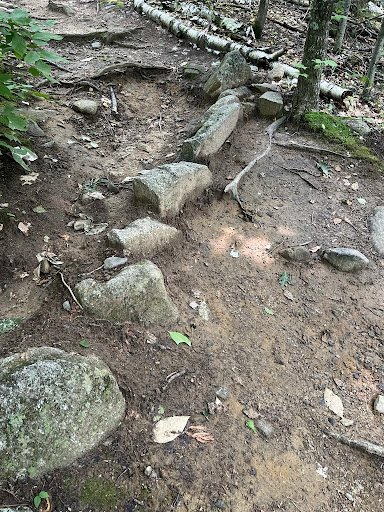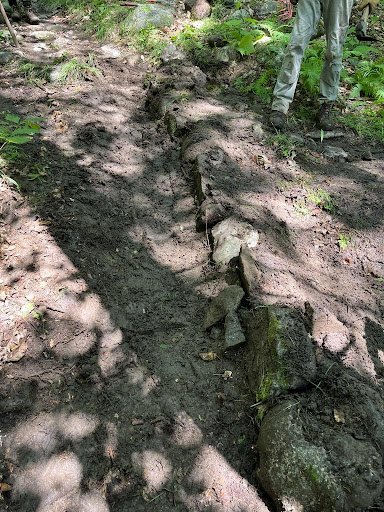Anatomy of a Water Bar
Have you been hiking recently and noticed a line of rocks sloping off the trail with not much of a ditch on the uphill side? Odds are you have likely seen a water bar that has been filled with sediment. Water bars are an important feature for moving water off the trail during rain events. Sometimes you may see a pressure-treated beam of wood, but these are more prone to decay than rocks. Water bars are essential in keeping the trail from eroding to allow for continued recreational use and enjoyment by hikers, big and small. Water bars may not always keep the water off the trail, as it can be muddy, flow directly down the trail, or pool at various points, but they assist in moving water off when it rains.
Water bar on Red Hill (Firetower) Trail, Red Hill, Moultonborough
The best water bars are constructed of rocks that stagger downslope to guide the water from the high point of the trail to the low point and off the mountainside. These rocks should be firmly in place in the ground with as much surface touching each other. You may have to cut and remove roots in order to place rocks in line. My AmeriCorps crew members and I often use metal rods called rock bars to remove and maneuver rocks into place. Additionally, they should be packed with dirt in between and on the downside of the rock to allow hikers to traverse over them. Furthermore, water bars should extend off the trail and fan out to guide the water down the hill while dispersing its energy. This requires routine maintenance of clearing dirt, debris, and leaves from the bars and their outlets to ensure they are functional.
Left: Water bar on the Mount Percival Trail, Mount Percival, Campton
Center: Water bar on the Faraway Mountain Trail, Castle in the Clouds, Moultonborough
Right: Water bar on the Piper Trail, Piper Mountain, Gilford
During our service term, we have worked with multiple volunteers and experts such as Lew Shelley of SnowHawk, an independent contractor who helps LRCT with more complicated projects and trail maintenance. He recommends that when building and maintaining trails, that you want to, “keep the trail out of the water and the water out of the trail.” This advice could not be more applicable to our service for the Lakes Region Conservation Trust given how rainy it has been for the month of June and now into July. This rain has tested the limits of water bars across the Lakes Region. Peggy from the Belknap Range Area Trail Tenders (aka the BRATTS) has mentioned that you want to have the depth of the water bar be about half the size of the rock and that you do not want a steep drop from the trail into the water bar—known as a cliff—as this causes further erosion of the trail. She also mentioned that you want the bar to be a 45-degree angle from the trail to guide water downhill and not back onto the trail. Serving with this cheerful group of volunteers in the Belknap Range on two occasions has tremendously increased my knowledge of trail maintenance and shown me what to look for when doing trail work of my own.
In my time here serving with the Lakes Region Conservation Trust, I can confidently say that I have constructed, cleared, and conserved over 150 water bars. I feel like a semi-professional who, through hard work and sweat equity, has developed a greater appreciation for hiking.
Peyton is a half-year member serving with the Lakes Region Conservation Trust. Learn more about Peyton here!





